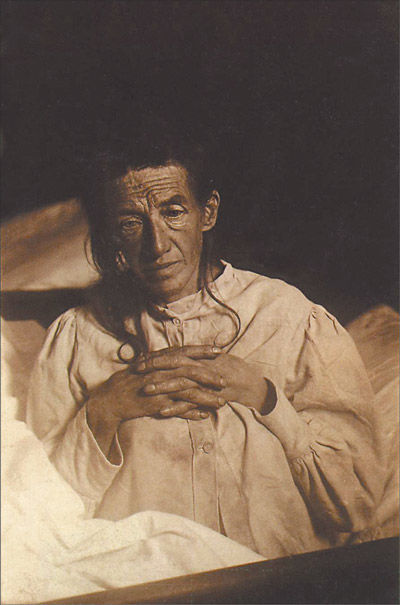Neuroscience
The Neuroscience of Behavior: Five Famous Cases
Five patients who shaped our understanding of behavior and the brain.
Posted January 16, 2020 Reviewed by Lybi Ma
“Considering everything, it seems we are dealing here with a special illness… There are certainly more psychiatric illnesses than are listed in our textbooks.” —Alois Alzheimer (In: Benjamin, 2018)
Once thought to be the product of demonic possession, immorality, or imbalanced humors, we now know that psychiatric symptoms are often caused by changes in the brain. Read on to learn about the people who helped us understand the brain as the driving force behind our behaviors.

Phineas Gage
In 1848, John Harlow first described the case of a 25-year-old railroad foreman named Phineas Gage. Gage was a "temperate" man: hardworking, polite, and well-liked by all those around him. One day, Gage was struck through the skull by an iron rod launched in an accidental explosion. The rod traveled through the prefrontal cortex of his brain. Remarkably, he survived with no deficits in his motor function or memory. However, his family and friends noticed major changes in his personality. He became impatient, unreliable, vulgar, and was even described as developing the "animal passions of a strong man." This was the first glimpse into the important role of the prefrontal cortex in personality and social behavior (David, 2009; Thiebaut de Schotten, 2015; Benjamin, 2018).
Louis Victor Leborgne
Pierre Broca first published the case of 50-year-old Louis Victor Leborgne in 1861. Despite normal intelligence, Leborgne inexplicably lost the ability to speak. His nickname was Tan, after this became the only word he ever uttered. He was otherwise unaffected and seemed to follow directions and understand others without difficulty. After he died, Broca examined his brain, finding an abnormal area of brain tissue only in the left anterior frontal lobe. This suggested that the left and right sides of the brain were not always symmetric in their functions, as previously thought. Broca later went on to describe several other similar cases, cementing the role of the left anterior frontal lobe (now called Broca’s area) as a crucial region for producing (but not understanding) language (Dronkers, 2007; David, 2009; Thiebaut de Schotten, 2015).

Auguste Deter
Psychiatrist and neuropathologist Aloysius Alzheimer described the case of Auguste Deter, a 56-year-old woman who passed away in 1906 after she developed strange behaviors, hallucinations, and memory loss. When Alzheimer looked at her brain under the microscope, he described amyloid plaques and neurofibrillary tangles that we now know are a hallmark of the disease that bears his name. This significant discovery was the first time that a biological molecule such as a protein was linked to a psychiatric illness (Shorter, 1997; David, 2009; Kalia & Costa e Silva, 2015).
JP
In 1933, Spafford Ackerly described the case of "JP” who, beginning at a very young age, would do crude things like defecate on others' belongings, expose himself, and masturbate in front of other children at school. These behaviors worsened as he aged, leading to his arrest as a teenager. He was examined by Ackerly who found that the boy had a large cyst, likely present from birth, that caused severe damage to his prefrontal cortices. Like the case of Phineas Gage, JP helped us understand the crucial role that the prefrontal cortex plays in judgment, decision-making, social behaviors, and personality (Benjamin, 2018).
HM (Henry Gustav Molaison)
William Scoville first described the case of HM, a 29-year-old man whom he had treated two years earlier with an experimental surgery to remove his medial temporal lobes (including the hippocampus and amygdala on both sides). The hope was that the surgery would control his severe epilepsy, and it did seem to help. But with that improvement came a very unexpected side effect: HM completely lost the ability to form certain kinds of new memories. While he was still able to form new implicit or procedural memories (like tying shoes or playing the piano), he was no longer able to form new semantic or declarative memories (like someone’s name or major life events). This taught us that memories were localized to a specific brain region, not distributed throughout the whole brain as previously thought (David, 2009; Thiebaut de Schotten, 2015; Benjamin, 2018).
Facebook/LinkedIn image: Gorodenkoff/Shutterstock
References
Benjamin, S., MacGillivray, L., Schildkrout, B., Cohen-Oram, A., Lauterbach, M.D., & Levin, L.L. (2018). Six landmark case reports essential for neuropsychiatric literacy. J Neuropsychiatry Clin Neurosci, 30, 279-290.
Shorter, E., (1997). A history of psychiatry: From the era of the asylum to the age of Prozac. New York: John Wiley & Sons, Inc.
Thiebaut de Schotten, M., Dell'Acqua, F., Ratiu, P. Leslie, A., Howells, H., Cabanis, E., Iba-Zizen, M.T., Plaisant, O., Simmons, A, Dronkers, N.F., Corkin, S., & Catani, M. (2015). From Phineas Gage and Monsieur Leborgne to H.M.: Revisiting disconnection syndromes. Cerebral Cortex, 25, 4812-4827.
David, A.S., Fleminger, S., Kopelman, M.D., Lovestone, S., & Mellers, J. (2009). Lishman's organic psychiatry: A textbook of neuropsychiatry. Hoboken, NJ: Wiley-Blackwell.
Kalia, M., & Costa e Silva, J. (2015). Biomarkers of psychiatric diseases: Current status and future prospects. Metabolism, 64, S11-S15.
Dronkers, N.F., Plaisant, O., Iba-Zizen, M.T., & Cabanis, E.A. (2007). Paul Broca's historic cases: High resolution MR Imaging of the brains of Leborgne and Lelong. Brain, 130, 1432–1441.
Scoville, W.B., & Milner, B. (1957). Loss of recent memory after bilateral hippocampal lesions. J. Neurol. Neurosurg. Psychiat., 20, 11-21.


